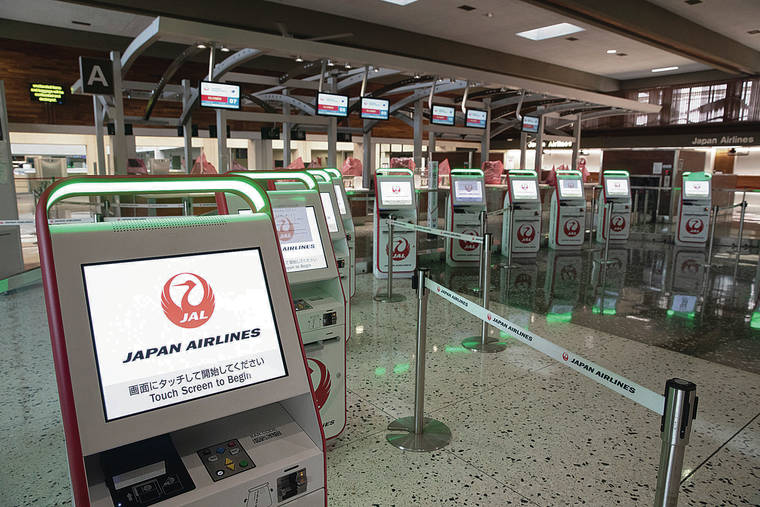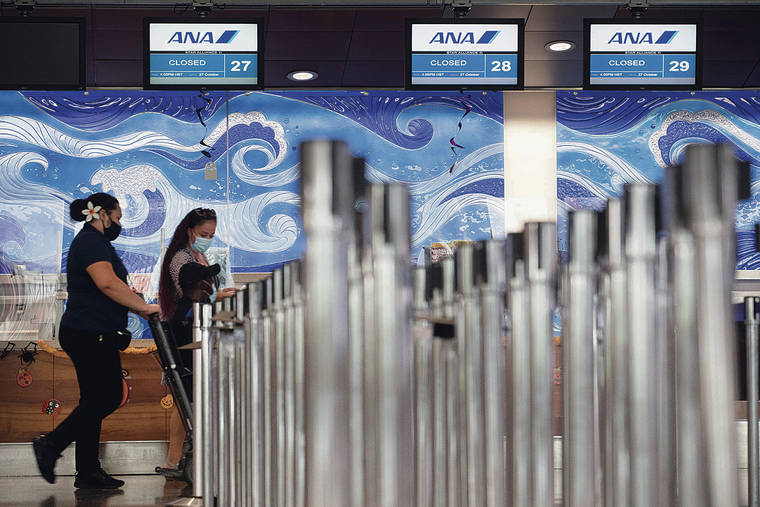Hawaii to welcome Japanese travelers next month through the state’s pre-arrival testing program


GEORGE F. LEE/GLEE@STARADVERTISER.COM
Japan Airlines’ ticket counters, kiosks and baggage handling areas were deserted Tuesday at Daniel K. Inouye International Airport.

GEORGE F. LEE/GLEE@STARADVERTISER.COM
Travelers and passersby walked past the closed All Nippon Airways ticket counter Tuesday at Daniel K. Inouye International Airport. ANA, Japan Airlines and Hawaiian Airlines have announced service to Hawaii will return in November.



Come next month, visitors from Hawaii’s top two tourism markets — the U.S. and Japan — can participate in Hawaii’s pre-arrival testing program.
Domestic passengers, since Oct. 15, have been able to bypass the state’s mandatory 14-day self-quarantine if they can provide proof of a negative COVID-19 test taken 72 hours prior to their departure for Hawaii.
It took longer to add Japanese travelers because government officials in Hawaii and Japan had to agree on a testing protocol, which starts Nov. 4 in Japan with the first travelers arriving Nov. 6 on incoming flights to Hawaii.
“Many of Hawaii’s residents trace their ancestry back to Japan, and welcoming our Japanese guests back to Hawaii is an important step in maintaining the close relationship between our two regions,” Gov. David Ige said Tuesday at a news conference at Daniel K. Inouye International Airport. “We believe we have created the safest travel testing program in the country, and we are grateful to the Japanese government for assisting us in making our pre-travel testing program available to its residents.”
Based on the first 12 days of the Safe Travels Hawaii trans-Pacific entry program, government and tourism officials are hopeful but realistic about the state’s fledgling tourism recovery, which will soon include traffic from Japan.
Last year these markets combined supplied about 86% of the nearly 10.3 million visitors who came to Hawaii by air. Roughly 7 million U.S. visitors flew to Hawaii in 2019, while 1.5 million Japanese visitors traveled here by air.
Don't miss out on what's happening!
Stay in touch with breaking news, as it happens, conveniently in your email inbox. It's FREE!
Projections for this year will be significantly lower, given that in the first eight months of 2020, total visitor arrivals decreased 69% to just 2.2 million visitors, with only 1.5 million or so of them from the U.S. and not quite 295,000 from Japan.
The number of Japanese visitors willing to come to Hawaii during the pandemic will be limited in part because of a requirement from the Japanese government that Japanese nationals traveling abroad complete a 14-day quarantine upon returning to Japan. Also, the Japanese government still has the U.S. listed under a “level three” travel restriction, which advises Japanese citizens to “reconsider travel” to the U.S.
Hawaiian Airlines president and CEO Peter Ingram said during a Tuesday earnings call that the carrier continues to plan for its overall operations to be 15% to 25% lower in the summer of 2021 than they were in the summer of 2019. Still, Ingram said that “early returns (from the pre-arrival testing program) are encouraging.”
“We expect demand will continue to improve in the months ahead, and we are expanding and will continue to expand our schedule to meet this demand,” he said. “We have indeed seen an increase in our load since Oct. 15 and have seen positive trends in our booking. While there is a very long road yet to be traveled, it is encouraging to have begun the journey.”
Lt. Gov. Josh Green said the first 12 days of the Safe Travels Hawaii program brought 94,718 passengers, including trans-Pacific and interisland travelers.
Green said 81,485 passengers did not have to quarantine. But some 10,047 were placed into quarantine because they did not get a test or present a qualifying test, he said.
Ingram said logistics are going relatively well, although “there have been some teething pains, to be sure, that are being worked through by the state and that are improving every day.”
Thousands of travelers arriving in Hawaii during the first week of the state’s pre-arrival testing program got stuck quarantining because their test results needed to be verified manually. On average, these visitors waited for three or four days before the state provided a decision on whether they could be released from their quarantine. But some told the Honolulu Star-Advertiser that they had waited five or more days.
Green said the state is making improvements to Safe Travels Hawaii. He said the manual verification backlog is getting better, although about 700 to 800 arriving passengers per day continue to come into the state needing a manual review.
Meanwhile, the state is scrambling to keep up with traveler inquiries to its info@gohawaii.com email account and its 800-gohawaii call center, which handles travel calls and fields health calls to the state Department of Health and technical questions to the Safe Travels Hawaii help desk.
As many as 20 staff members from the Hawaii Visitors and Convention Bureau and its Island Chapters, whose main function is normally marketing Hawaii tourism, have been added to the call center contractor’s team to handle the rise in calls.
Just prior to the Oct. 15 start of Hawaii’s pre-arrival testing program, about 400 to 500 calls a day were coming into the 800-gohawaii call center, said Darlene Morikawa, spokeswoman for the Hawaii Visitors and Convention Bureau, which serves as the clearinghouse for calls to 800-gohawaii.
On Oct. 21, Morikawa said the call center received 2,695 calls.
“Our team members are assisting callers with questions ranging from the new pre-travel process and walking them though the many steps of traveling to Hawaii,” Morikawa said. “We’re also receiving inquiries from travelers who have arrived and are navigating through the Safe Travels online program and how to manage the manual verification process caused by issues with their test documentation.”
Most of the call center’s pre-travel questions are about where travelers can get tests that meet the state’s requirements, she said. The call center also has started to receive calls about what’s required to travel from one island to another, Morikawa added.
Government and tourism officials expect the start of a pre-arrival testing program with Japan will go more smoothly as the state has already worked out some kinks since beginning its pre-arrival testing program for U.S. trans-Pacific travelers.
Japanese visitors can find more information on www.Allhawaii.jp Opens in a new tab, the main Hawaii Tourism Japan website, which houses COVID-19 information. Hawaii Tourism Japan, Hawaii Tourism Authority’s Japan marketing contractor, also has released a video, youtu.be/SPAvNIF65is Opens in a new tab, to help travelers from Japan navigate Hawaii’s new entry requirements.
Ige said the agreement with Japan will kick off with 21 trusted testing partners. Ige said All Nippon Airways, Japan Airlines and Hawaiian Airlines have announced the return of service, and between them are offering 10 scheduled flights for November.
“Right now we believe only a few thousand visitors from Japan will come to Hawaii, and we expect that we’ll finish the year just shy of 300,000 arrivals,” said Eric Takahata, HTJ managing director.
Oahu will benefit the most from the restart of tourism from Japan, Takahata said. There aren’t any flights currently scheduled to travel from Japan to Hawaii island, the state’s other international port of entry, through the end of the year, he said.




